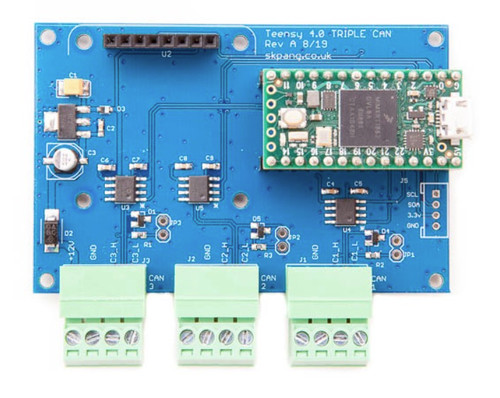Blog
Recent Posts
CAN Bus Shield for Arduino, Mbed Platform With Fault-Tolerant MAX33040E CAN Transceiver
Posted by on
The MAX33040Eshld shield evaluation kit by maxim integrated represents a demonstration and development platform for the MAX33040E CAN Bus transceiver. It serves as a standalone evaluation board and the Mbed or Arduino platform to communicate with a CAN Bus network. The board features test points to access critical signal pins of the transceiver. The MAX14931 digital isolator is used as a level translator with a 1.71 VDC to 5.5 VDC supply range which also feeds the micro-controller. The onboard microSD card socket supports OBD-II (vehicle diagnostics) applications.
The MAX33040E/MAX33041E are +3.3 VDC Controller Area Network (CAN) transceivers with integrated protection for industrial applications. These devices possess extended ±40V fault protection on CAN_H and CAN_L for equipment where overvoltage protection is required. They also incorporate high ±40 kV ESD HBM and an input common-mode range (CMR) of ±25V on CAN_H and CAN_L, exceeding the ISO 11898-2 CAN Standard of -2V to +7V. This makes these parts well suited for applications enduring moderate electrical noise, influencing the ground levels between two nodes or systems. The transceiver features a shutdown pin and a multifunction standby pin.
Key Features
- Easy Evaluation of the MAX33040E CAN Bus Transceiver
- I/O Interface Compatibility from 1.71 VDC to 5.5 VDC
- Proven PCB Layout
- Mbed™/Arduino® Platform +
- Fully Assembled and Tested
Teensy 4.0 Triple CAN Bus Board With Two CAN 2.0B And One CAN FD Port
The Teensy 4.0 Triple CAN Bus Board is a Teensy 4.0 board with triple CAN Bus connections, two Classical CAN 2.0B, and one CAN FD. It can be powered by an external +12 VDC power supply with reverse voltage protection.
The Teensy 4.0 is an Arduino-compatible board with an Arm Cortex-M7 microcontroller running at 600 MHz. The board is compatible with the Arduino IDE and the Arduino library. In most cases, code written for another Arduino board works with a minimum of changes on a Teensy.
Out‑Of‑The‑Box Rapid Prototyping Solution For IoT Applications That Support GSM, UMTS And CDMA Networks
The u‑blox C027 application board serves as a rapid prototyping solution for Internet-of-Things (IoT) applications that require support for GSM, UMTS, and CDMA networks. The board comes with a MAX‑M8Q GPS/GNSS receiver and a LISA UMTS/CDMA or SARA GSM cellular module, allowing a smooth development of location‑aware, global communication applications. The C027 utilizes the powerful and flexible open‑source ARM [...]
Embedded Programming With STM32 Nucleo Boards
The STM32 Nucleo family of processors, manufactured by STMicroelectronics, are low-cost ARM microcontroller development boards. This book describes development projects using the popular Nucleo development board. The first chapters of the book briefly describe the architecture of the Nucleo family. Additional chapters address software development tools for the Nucleo boards such as mbed, Keil MDK, TrueSTUDIO, and the [...]
2G/3G Rapid Prototyping With ARM Mbed Enabled Internet Of Things Development Kit
The u‑blox C027 application board is an out‑of‑the‑box rapid prototyping solution for IoT (Internet of Things) applications that support GSM, UMTS and CDMA networks. The development board holds a MAX‑M8Q GPS/GNSS receiver and a LISA UMTS/CDMA or SARA GSM cellular module, enabling straightforward development of location‑aware, global communicating applications. For an even more natural development, the C027 incorporates [...]
STM32 Development Board Implements CAN FD On-Chip Modules, Supports Arduino And ARM mbed Platforms
ST Microelectronics announced their Nucleo-144 boards, featuring an STM32 micro-controller in an LQFP144 package. The board’s Zio connector enables connection to Arduino Uno V3. The development board does not require any separate probe as it integrates the Link/V2-1 debugger/programmer. It comes with Ethernet and USB connectors. The board is not equipped with CAN transceiver, although the STM32 [...]
Technical Literature: Embedded Systems Design With mbed LPC1768
This post is part of a series on CAN Bus and SAE J1939 Prototyping with the ARM Cortex M3 processor. Fast and Effective Embedded Systems Design: Applying the ARM mbedFast and Effective Embedded Systems Design is a fast-moving introduction to embedded system design, applying the innovative ARM mbed and its web-based development environment. Each chapter introduces [...]
mbed LPC1768 Baseboards With CAN Bus (Controller Area Network) Port
This post is part of a series on CAN Bus and SAE J1939 Prototyping with the ARM Cortex M3 processor.I will take a risk by repeating myself over and over again by saying that the mbed LPC1768, as well as the Arduino Due, is utterly useless in its bare form. In order to accomplish any [...]
App Note: ARM Cortex M3 Development Boards Require External CAN Bus Transceiver
The ARM Cortex-M is a group of 32-bit RISC ARM processor cores licensed by ARM Holdings. The cores are intended for microcontroller use, and consist of the Cortex-M0, M0+, M1, M3, M4, and M7. The ARM Cortex-M3 processor is very well suited for highly deterministic real-time applications, even for low-cost platforms, such as automotive body systems, industrial control systems, wireless [...]
App Note: mbed LPC1768 Development Kit With CAN Bus Breakout Board
The mbed Microcontrollers are a series of ARM microcontroller development boards designed for rapid prototyping. The mbed NXP LPC1768 Microcontroller in particular is designed for prototyping all sorts of devices, especially those including Ethernet, USB, and the flexibility of lots of peripheral interfaces and FLASH memory. It is packaged as a small DIP form-factor for [...]
 Loading... Please wait...
Loading... Please wait...


